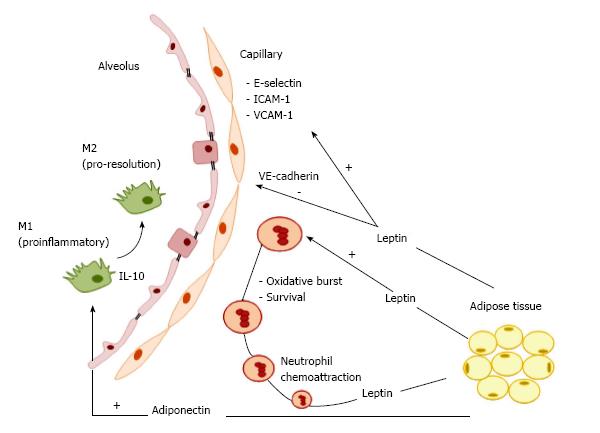Copyright
©The Author(s) 2017.
World J Crit Care Med. Aug 4, 2017; 6(3): 140-152
Published online Aug 4, 2017. doi: 10.5492/wjccm.v6.i3.140
Published online Aug 4, 2017. doi: 10.5492/wjccm.v6.i3.140
Figure 1 Model of obesity-associated pulmonary inflammation.
Lung immune cells and inflammation due to obesity. Leptin is implicated in inflammatory respiratory diseases as a neutrophil chemoattractant. The association between obesity and LPS-induced lung inflammation involves an increase in monocytes and lymphocytes, as well as in intracellular adhesion molecule (ICAM)-1 expression in alveolar macrophages, suggesting their polarization toward a pro-inflammatory M1 phenotype. Obesity impairs vascular homeostasis, facilitating increased susceptibility to inflammatory lung vascular diseases by affecting structural cells in the alveolar-capillary membrane. The lung endothelium of obese mice has been shown to express higher levels of leukocyte adhesion markers (E-selectin, ICAM-1, VCAM-1) and lower levels of junctional proteins (VE-cadherin and β-catenin). Adiponectin has anti-inflammatory properties, mainly by its effects on toll-like receptor (TLR) pathway-mediated NF-κB signaling, which regulates the shift from M1 to M2 macrophage polarization, and suppresses differentiation of M1 macrophages by downregulating the pro-inflammatory cytokines TNF-α, MCP-1, and IL-6. Adiponectin also promotes expression of the anti-inflammatory factor IL-10 in macrophages via cAMP-dependent mechanisms. TNF: Tumor necrosis factor; IL: Interleukin; LPS: Lipopolysaccharide.
- Citation: Heil LBB, Silva PL, Pelosi P, Rocco PRM. Immunomodulatory effects of anesthetics in obese patients. World J Crit Care Med 2017; 6(3): 140-152
- URL: https://www.wjgnet.com/2220-3141/full/v6/i3/140.htm
- DOI: https://dx.doi.org/10.5492/wjccm.v6.i3.140









